Guppies (Poecilia reticulata) are a fascinating fish breed. This freshwater tropical fish originates in South America.

They are relatively easy to care for and are suitable for those new to aquarium keeping.
Commercially, you can find them in a wide array of colors and sizes, giving them one of their common nicknames: the rainbow fish.
They are live-bearing fish, meaning they give birth to fully-formed, free-swimming young.
One thing to know when keeping guppies is that they are prolific breeders and are capable of bearing up to 2,000 young in the lifetime of a single female.
This ability has given the guppy another one of its common names: the millions fish.
Knowing how to identify male versus female guppies is the first step.
Read on for more information on how to know if your guppy is pregnant, how to prepare for the birth, and how to care for the baby guppies.
Guppy Biology
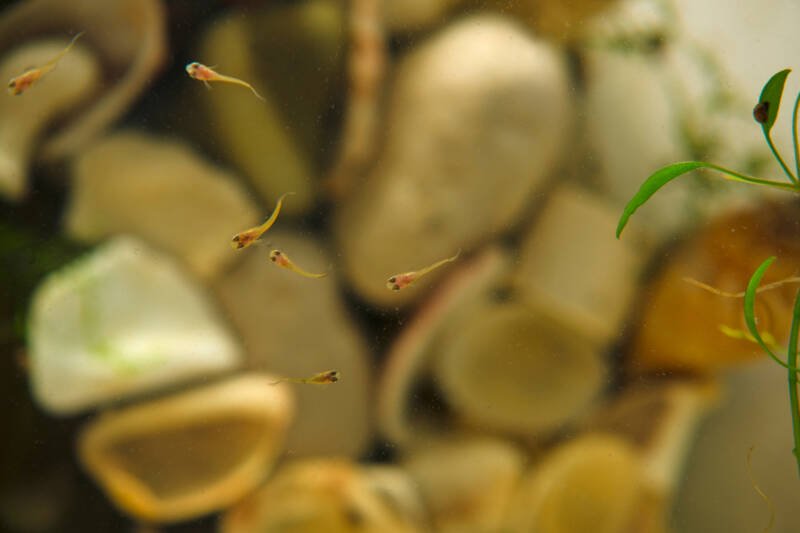
As we said, guppies are extremely fertile fish and can breed when they are as young as one month old!
Guppies’ gender develops at four weeks. At six weeks, they are sexually active. The average age for first breeding is between three to five months.
Chances are if you have a male and female guppy in your tank, you have a pregnant female!
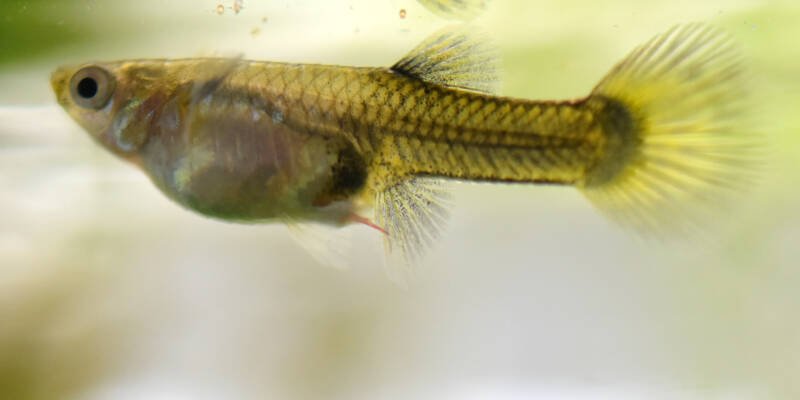
Knowing which fish are male and which are female is important.
Look under your guppy’s tail, toward the back part of the stomach, and near the anal fin for a dark spot, also known as the gravid patch. These fish are your females.
Keep the males and females separate until you are ready to breed them to maintain population control.
A female guppy can store sperm from one insemination for up to a year and can become pregnant up to eight times from that single event!
In fact, a female guppy can become pregnant again a mere few hours after having just given birth!
While the average number of fry per birth is 30 to 60, your female can give birth to as many as 200 fry from one pregnancy.
Guppy Breeding Behavior
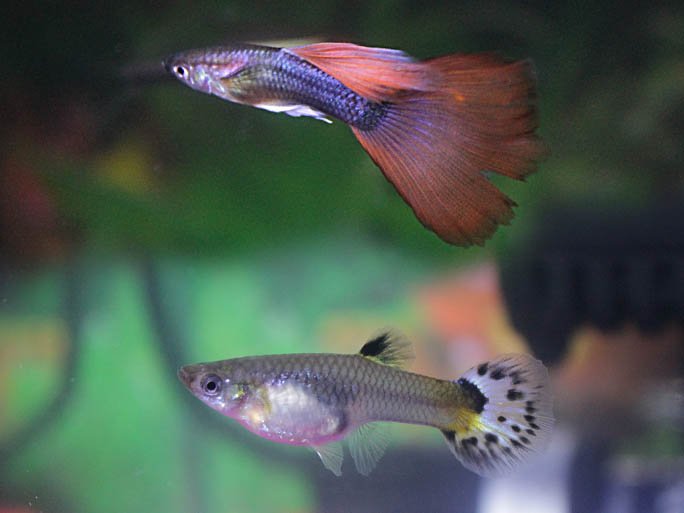
The male guppy will chase the female around the tank. When he is close enough, he will quickly extend his gonopodium, a long, narrow adaptation to the anal fin.
He will pass a sperm packet to the female’s anal vent, located just behind the gravid spot.
Mating is quick and may occur multiple times to ensure insemination.
You may mistake the quick action as aggression at first, but once you are familiar with it, you will recognize it as mating behavior.
Guppy Gestation Period
The gestation period for female guppies is typically less than one month but can range from 21 to 31 days.
Once you notice that your female guppy is pregnant, remove her from the community tank to a separate breeding tank.
Identifying Your Pregnant Guppy
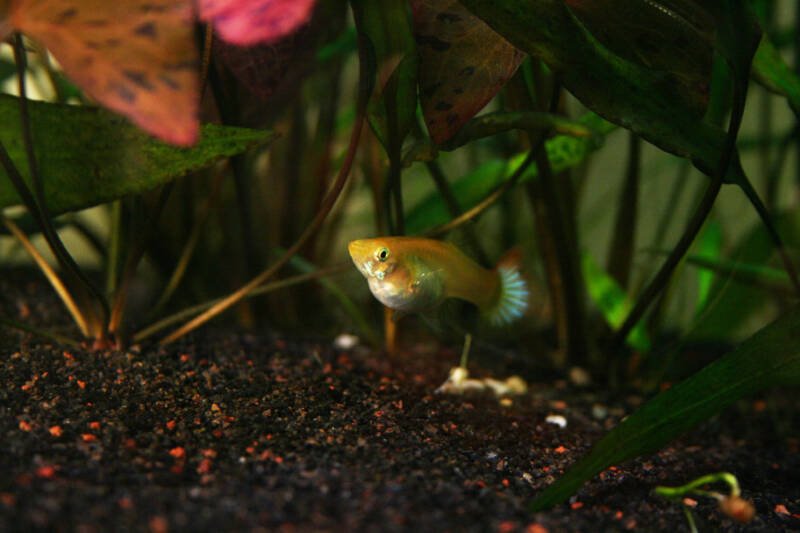
To determine whether your female guppy is pregnant, look for changes in the gravid spot. It will become darker and larger as the babies grow.
Your guppy will grow in girth considerably and may appear “boxy” shaped. Her color may fade.
Once she is fairly close to giving birth, her gravid spot will appear black. You may even be able to see the eyes of the fry through your female’s belly wall.
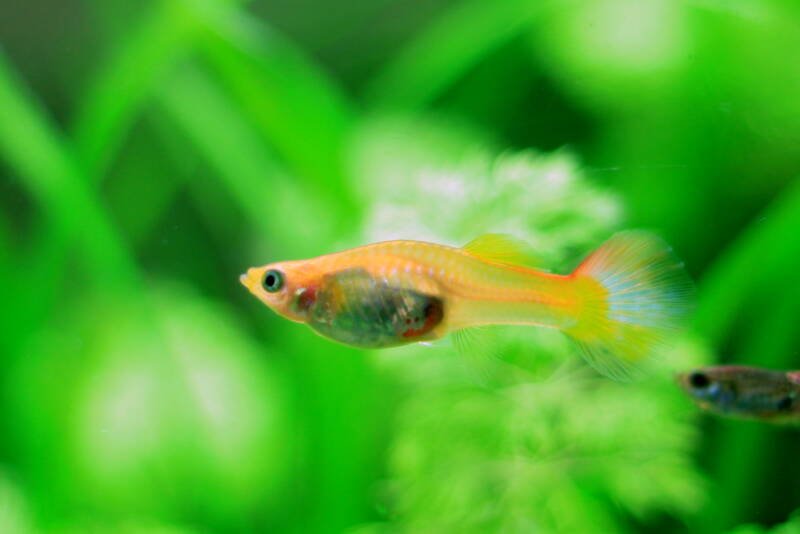
Other indications that your female is well along in her pregnancy are changes in her behavior.
You may notice your female guppy is not as active, tending to stay in one location. She may also become shy or more aggressive.
She might eat everything in sight or next to nothing. When it is close to her time to give birth, she may look like she is pushing and may have an arch to her back.
She may also have difficulty swimming and may breathe rapidly.
Maintaining the Tank
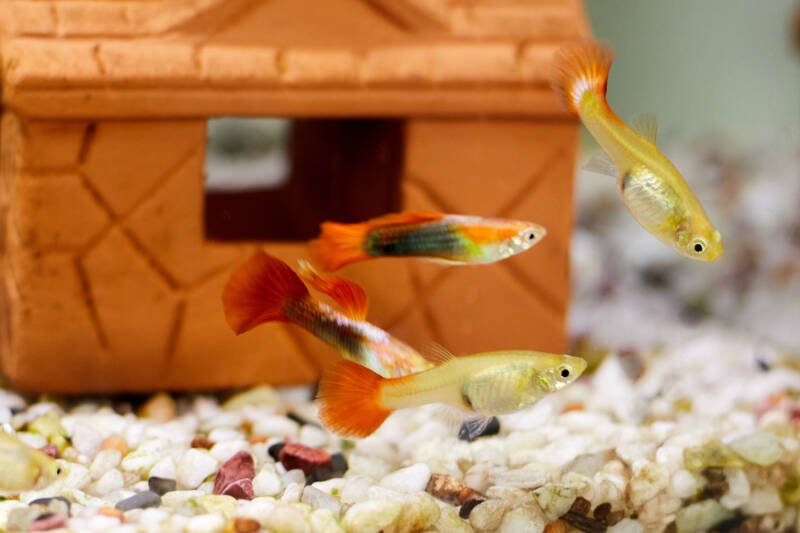
In the best practice, set up two tanks: one for the fry to be born in and another to let mom recover in for one to two days before you return her to the community tank.
A ten-gallon tank is a good size for your breeding tank.
Water Parameters
Maintain the water pH range between 7.0 and 7.6 and clean the tanks regularly.
You want to control any algae or waste buildup that can impact the health of your fish. Change 25% of the water every week.
Install a sponge filter to keep the water clean. The water hardness should be from 7 to 12 dGH.
Raise the water temperature in the tank to between 77 and 79°F (25 to 26°C) to encourage a natural gestation progression and help the birth along.
Take care to monitor the water temperature, as fluctuations can stress your female and impact the chances of a successful birth.
Lighting
The guppy fry need from 8 to 12 hours of light per day for healthy development. Use a medium tank light, LED, or ambient room lighting.
Setting the light on a timer will help keep a regular schedule. Adding a dimmer can simulate sunrise and sunset conditions to lessen the stress to your fish.
Keep the Fry Separate
Keeping the fry separate from the community tank and the mother is important, as the mature fish may eat the fry.
While a separate tank is easiest, there are mesh pieces you can purchase to hang either in the birthing tank or community tank to keep the fry safe. Mesh net boxes are also an option.
In addition, having some dense, planted areas will give the fry places to hide. Both artificial and natural aquarium plants will serve this purpose.
Feeding Your Pregnant Guppy

The further along your guppy is in her pregnancy, the less she will likely eat. Give her several small meals each day, and then just a small bit.
You do not want leftover fish food floating around, so she should be able to finish what you give her in five minutes.
Nutrition is important for a healthy mom and babies. In addition to a good quality flake food, consider supplementing with the following live or frozen foods:
- Brine shrimp (fresh or frozen)
- Spirulina flakes
- Bloodworms
- Mosquito larvae
- Daphnia
- Vegetables, such as lettuce, peas, or zucchini
The Actual Birth
A typical birth can take anywhere from two to six hours. Occasionally, the process can start and stop or can extend over a longer period. In these cases, the fry may not be viable.
If the birthing process has stopped, return the female to the community tank for a day or so as isolation will stress your fish.
When they are born, the guppy fry are curled into little balls. Healthy fry will uncurl and begin swimming quickly.
If you observe any unhealthy or stillborn fry sinking to the bottom, remove them from the tank as soon as possible.
After Your Guppy Gives Birth
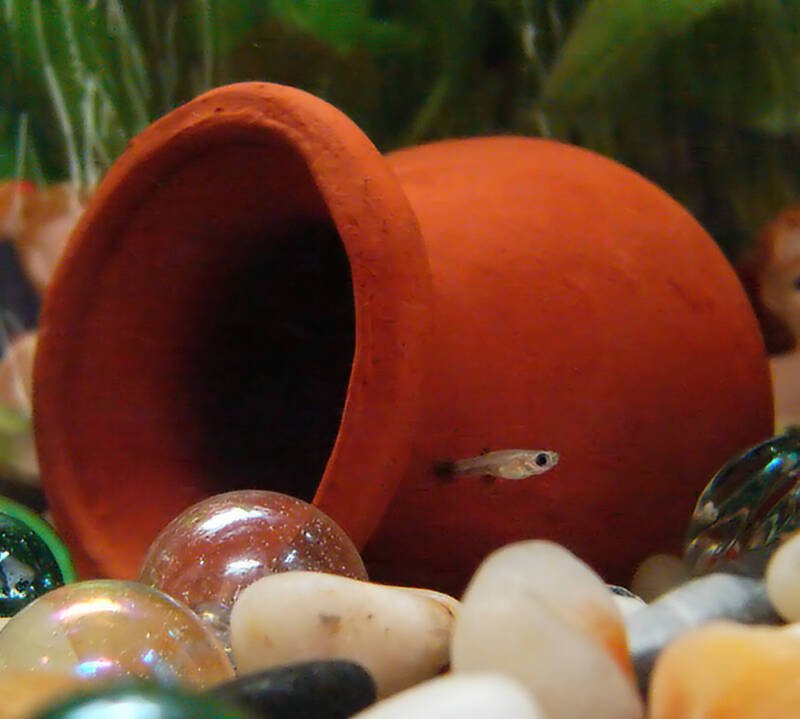
After your female gives birth, separate her from the fry, either through the use of a mesh or another tank. This is necessary as she may eat the fry, seeking the nourishment she needs to recover.
Isolate her for one to two days. During this time, feed her well and regularly.
A variety of high-quality, high-nutrient foods will allow her to regain nutrients lost in the birthing process.
Do not separate her for longer than this time as the isolation can further stress your fish.
After returning her to the community tank, remember that a female can become pregnant multiple times from a single insemination. Keep an eye on her because she may be ready to give birth again in another 21 to 31 days.
Fry Care and Feeding
Your newborn fry will require very small-sized food at first. Feed them often, up to five times a day.
Excellent foods to feed your fry include:
- Pulverized flakes
- Baby brine shrimp
Guppy adults are from 0.6 to 2.4 inches in length. The fry are about ¼ in length when they are born and grow approximately 0.3 inches per month.
Keep the fry separate until they are about one-half inch in length. Then you can introduce them to the community tank.
Final Thoughts
Knowing a little about guppy biology and reproductive habits will go a long way toward keeping your fish happy and healthy.
If you plan on simply keeping guppies for their look, then consider keeping a group of males only.
You will enjoy the beautiful coloration of the males and not have to worry about any guppy fry.
If you do plan on breeding them, learn how to care for your pregnant female guppy throughout her pregnancy properly.
Preparing a separate tank or area for the fry to be born will protect them.
Feeding the fry a mix of nutrient-rich foods and maintaining water quality and conditions will help ensure that your fry reach maturity and can be introduced into the community tank.
Have you successfully bred your guppy fish?
What have you found works best for a breeding tank setup?